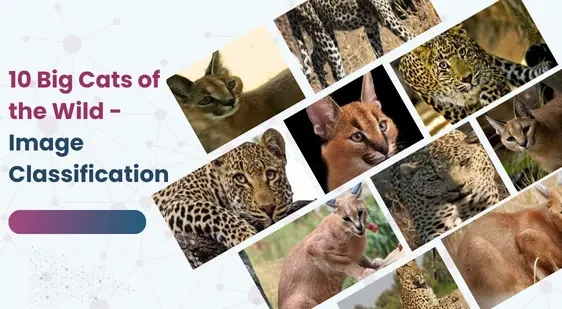10 Big Cats of the Wild - Image Classification
Home » Dataset Download » 10 Big Cats of the Wild – Image Classification
10 Big Cats of the Wild - Image Classification
Datasets
10 Big Cats of the Wild - Image Classification
File
10 Big Cats of the Wild - Image Classification
Use Case
Computer Vision
Description
Images were gathered from Google searches and downloaded using app 'download all images' . I highly recommend this app as it is very fast returns a zip file with the images which you can then unzip to a specific directory.

About Dataset
Images were gathered from Google searches and downloaded using app ‘download all images’. I have developed a custom set of tools to create datasets. The first tool used creates a dataset framework in a specified directory I call Datasets. It inputs the name of the new dataset and creates a directory with that name and within that directory creates 4 subdirectories train, test, valid and storage. The storage directory is where the unzipped downloaded images are placed. I wrote a python program called order_by_size. It operates on the downloaded images, within the storage directory, It removes files with extensions that are not jpg, png, or bmp and deletes files that are below a user specified image size. 1. Lion (Panthera leo)
Lions are often referred to as the kings of the jungle. These majestic cats are renowned for their strength, social structure, and distinctive manes.
Identification Features:
- Mane: Males have a prominent mane that varies in color from blond to black.
- Body: Robust and muscular build.
- Color: Tawny coat with a lighter underbelly.
Habitat:
Lions primarily inhabit savannas, grasslands, and open woodlands in Africa.
2. Tiger (Panthera tigris)
The tiger is the largest of all wild cats and is easily recognizable by its striking coat of vertical black stripes on reddish-orange fur.
Identification Features:
- Stripes: Unique pattern of vertical black stripes.
- Size: Largest of all big cats.
- Color: Reddish-orange coat with a white underbelly.
Habitat:
Tigers are found in a variety of habitats, including tropical forests, grasslands, and swamps across Asia.
3. Leopard (Panthera pardus)
Leopards are known for their adaptability and elusive nature. They are one of the most widespread big cats.
Identification Features:
- Spots: Rosette-shaped spots on a golden coat.
- Build: Slender and muscular.
- Tail: Long, helps in balance.
Habitat:
Leopards thrive in diverse habitats, from rainforests to deserts, across Africa and parts of Asia.
4. Snow Leopard (Panthera uncia)
Identification Features:
- Fur: Thick, smoky-gray fur with black rosettes and spots.
- Tail: Long and bushy, aids in balance and warmth.
- Build: Stocky with powerful limbs.
5. Cheetah (Acinonyx jubatus)
Identification Features:
- Build: Sleek, slender body with long legs.
- Spots: Small, round black spots on a tan coat.
- Tear Marks: Distinctive black tear marks from eyes to mouth.
Habitat:
Cheetahs inhabit open savannas and grasslands in Africa, with a small population in Iran.
6. Jaguar (Panthera onca)
The powerful jaguar is known for its formidable strength and beautiful coat.
Identification Features:
- Build: Stocky and muscular with a broad head.
- Spots: Large rosettes with a central spot on a golden coat.
7. Puma (Puma concolor)
Identification Features:
- Color: Uniformly tan or tawny coat.
- Build: Sleek and agile with a long tail.
- Face: Round ears and a distinctive facial marking.
Habitat:
Pumas have the largest range of any wild terrestrial mammal in the Americas, from Canada to the southern Andes.
8. Clouded Leopard (Neofelis nebulosa)
Identification Features:
- Spots: Large, cloud-like markings on a smoky-gray or yellowish coat.
- Build: Medium-sized with short legs and large paws.
- Tail: Long and used for balance.
9. Sunda Clouded Leopard (Neofelis diardi)
A close relative of the clouded leopard, the Sunda clouded leopard inhabits the islands of Borneo and Sumatra.
Identification Features:
- Behavior: Largely arboreal and elusive.
Habitat:
This species is exclusive to the rainforests of Borneo and Sumatra.
10. Asiatic Lion (Panthera leo persica)
The Asiatic lion is a subspecies of the lion found in the Gir Forest of India.
Identification Features:
- Build: Slightly smaller with a distinct belly fold.
- Color: Tawny coat similar to African lions.
Habitat:
The Asiatic lion’s habitat is restricted to the Gir Forest and surrounding areas in India.
Conclusion
The diversity and beauty of these 10 big cats of the wild are truly remarkable. Each species plays a crucial role in its ecosystem and represents the pinnacle of evolutionary adaptation.
This dataset is sourced from Kaggle.
Contact Us

Quality Data Creation

Guaranteed TAT

ISO 9001:2015, ISO/IEC 27001:2013 Certified

HIPAA Compliance

GDPR Compliance

Compliance and Security
Let's Discuss your Data collection Requirement With Us
To get a detailed estimation of requirements please reach us.
